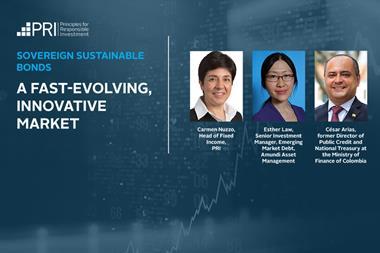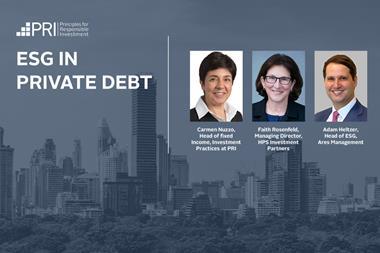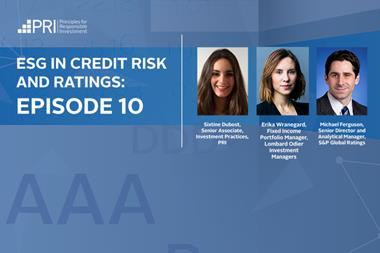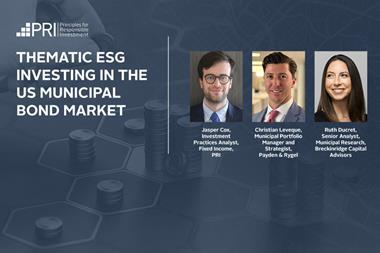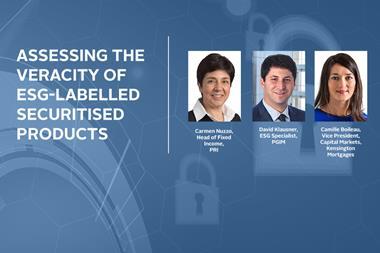Find the podcast transcript here.
ESG data: Is it different for securitised products?
Carmen Nuzzo
Hello and welcome to this PRI podcast on securitized products. I’m Carmen Nuzzo, the head of the fixed income program at the PRI. As the adoption of responsible investment practices continues to grow, so does the need for ESG data to inform investment decisions. The problems with the sheer variety of data or existing gaps and the reporting inconsistency are widely discussed in public forums for traditional securities such as conventional bonds or equities. However, there is much less focus on securitized products, which are complex. In fact, for them. Data are required at different levels of the product structure. To discuss with me why and what ESG data is needed to create an analysed structure product, I’m joined today by Tina De Baere head of ESG at Cairn Capital and Alternative Credit Asset Manager. Tina also sits on the advisory committee to the PRI on securitized products and Daniella Siretz who’s managing director specialty finance at NatWest Market. Welcome to you both.
Tina De Baere
Thank you, Carmen.
Daniella Siretz
I’m thrilled to be here. I know we’ve got a lot to get through
Carmen Nuzzo
As well. Tina, let me start with you as an investor in securitized products. What do you use ESG data for?
Tina De Baere
In the PRI advisory committee, we’re focusing on securitized products, which are bonds backed by a specific portfolio of loans. That portfolio of loans could be a pool of residential or commercial mortgage loans. It could be unsecured consumer loans or corporate loans. For example, here at, we’ve been investing in securitized products, and we are also a CLO manager. The ESG analysis for securitized products can be done at three levels. It can be done at the key counterparty level. So, for example, at the mortgage originator level or the servicer level, it can also be done at the underlying portfolio level, and it can be done at the bond or securitization level. There are a couple of reasons that we need this type of data. We as asset managers, we need to demonstrate how ESG factors are integrated into our investment processes. We are also increasingly expected to provide ongoing reporting on ESG metrics for ESG performance.
Tina De Baere
The second reason why we need ESG data is because us as investors, we are faced with a new set of regulations that we need to comply with. What we’re finding in our experience that even if asset managers are not directly in scope of such regulations and investors have started requesting asset managers voluntary reporting in line of such new rules regardless. For example, we don’t need to report the carbon footprint of our CLO portfolios, but we are doing so to meet our investors’ needs.
And then finally, ESG information on investments help us to determine an investments eligibility for our funds or products. So, some investors will not be able to invest if issuers have weak ESG profiles, if issuers disclose insufficient ESG information or if issuers are involved in controversial business activities. And I think apart from this, I think it’s also better for companies to control their own narratives and publish this data themselves instead of investors relying on data from third parties.
Carmen Nuzzo
I think the last point is important. This data collection exercise is very important for the companies as well. Daniella, turning to you, you structured these products. How do you use ESG data for that purpose?
Daniella Siretz
We structure a whole host of securitized products with the underlying assets typically being consumer loans, but also any other kind of commercial real estate or anything else that can be ring fenced and evaluated appropriately. And in that capacity, we also act as a ranger for public market securitization. And I completely concur with everything that Tina’s already said about what investors seem to be looking at. I mean, the kind of questions that we get are that all maps over to what Tina has said somewhat embarrassingly. I think the first time we had an investor ask about ESG was on a road show in mid-2019. At the time, the originator didn’t even know what the acronym meant. The point had to be slightly fudged at the time, but now it’s completely unthinkable not to even have a basic set of slides on ESG in any marketing pack and anything that you bring to public roadshow process. We know certainly of investors who are aligning their funds to either meet, you know, Article 8 or Article 9 requirements.
Daniella Siretz
Those are SFDR terms to either promoting or indeed targeting sustainability objectives. So even if the underlying transaction that we’re bringing to market isn’t even labelled as ESG, we know that investors are consistently asking for the information to be made available. Tina’s already alluded to this, you know, securitizations are asset backed products. The initial focus is definitely on the ESG credentials of the underlying assets. I think that’s understood by everyone in the market, given that by and large securitizations is used as a funding tool for the relevant originating entity. Definitely a heightened originator focus as well. So, investors are keen to understand the credentials of that entity. You know, the entity that they’re supporting really by way of investing in the bonds. So, the more consistent disclosure that can be brought to market around the originator and where we see that already coming through, then that’s supportive of the market.
Carmen Nuzzo
And on this point, Daniella, on consistent disclosure everywhere when I talk to investors, they lament the lack of standardization of these data because for them it’s really important to compare the data across the different underlying assets. We have seen some traction in Europe this year in the use of industrywide data template. Do you think this is enough?
Daniella Siretz
So yeah, that was an important development I think for everyone because top of the line, every time there is any kind of industry poll or any questionnaire than it is always around data and consistency as you say. So, this was an effort by AFME to try and put together essentially due diligence questionnaire that originators can put together at the outset. The hope being that it is as comprehensive as it needs to be and that way when you come to road show a particular transaction, investors won’t need to ask bespoke questions. They won’t need to bombard the originator with multiple versions of essentially the same kind of questions just in differing depths or different focus areas at a point when you’re actually just trying to focus on marketing the deals. So, the originator prepares that due diligence questionnaire ahead. We have seen that being used.
Daniella Siretz
In fact, we see it being used almost exclusively, I would say for non ESG labelled transactions. Which kind of makes sense because for an ESG labelled transaction, I think the flood of data that you would need to bring to the market in terms of underlying narrative, whether it’s a green or a social bond framework and second party opinion providers reports, then you know you wouldn’t need the templated DD questionnaire in quite the same way. We also have additionally just more quantitative data points in the underlying data tapes. So, the standard data templates that we use for our public securitizations do have fields for energy performance. But I should say that that’s just EPC. So the grade of EPC, A, B, C, whatever it may be, but for example, the CO2 emissions data, which is also actually incorporated into the EPC certificate, isn’t part of the loan data tape.
Daniella Siretz
And also importantly, the provision of the EPC information isn’t always a mandatory data point. Even for the most, you know, prime and Liquid Asset backed deals labelled under the STS regime as it’s called, that information is only mandatory if it’s available. You know that standardization there are actually pushes for it as you say, but it isn’t quite enough yet. There’s data points that you need on the underlying assets, but there are also data requirements around the originator policies and those are by their nature just a little bit more qualitative rather than quantitative. They’re not, you know, extractable measurable data points and so on that front, standardization just isn’t a feature.
Carmen Nuzzo
Daniella, for the benefit of the audience, you mentioned the STS regulation, which is part of the securitized regulation of ASMA in Europe. STS stands for simple, transparent, and standardized. There is still a problem with the plurality of different questionnaires existing. So hopefully the industry will become over time a bit more aligned to promote similar standards or at least similar questions to be asked because we hear quite a lot, at least in the corporate sector, a lot of fatigue by corporates in reporting. And on the banking side it’s a very challenging task when it comes to collecting data at the time of dispersing these loans. Tina, we talk always as ESG as one acronym, but it’s actually different categories of factors, E, S and G. How do you determine whether focusing on E or S for example, to start with?
Tina De Baere
Sure. Well, there has been a lot of focus on environmental factors, especially on carbon admissions. And I think that’s because that’s a relatively easy concept to understand. It can be tracked, it can be measured and reported more easily and it’s also a comparable metric across companies and in industries, which is quite important, especially when you’re aggregating all this information on a portfolio basis. However, I think we may run the risk that it overshadows other essential ESG information. For example, on the social side, whether you focus on the E or the S I think is ultimately dependent on the relevance and the materiality to the business or to the investment you’re looking at. If your investment is backed by an auto loans portfolio compared to a European corporate loans portfolio, you’ll look at different ESG areas and you’ll assign different weights of importance to them. That E side is obvious for a vehicle which is forms part of an autoload portfolio.
Tina De Baere
It’s potentially material, especially given increasing regulations on the environmental performance of vehicles that in turn affect the subsequent market valuation of those assets. However, it’s also informative to understand how lenders are treating customers who are in arrears or are struggling making payments. And we want to understand this in the context of future litigation risk and reputational risk for the lender, which may ultimately affect our investment. On the other hand, when you’re looking at a corporate loans portfolio, the materiality of environmental or social factors will be dependent on the sector. For example, when you look at a software company versus a paper and packaging company for the letter, you’d inquire about the policies in place for raw material sourcing or the business’ use of plastics. How you balance the E and the S factors as an investor can also be very mandate dependent. So, meaning that our end investors may have a strong preference on either environmental or social topics. Not to forget the relevance of governance factors here and within securitized products, governance comes to play when analysing the ESG profiles of key counterparties, for example, such as the mortgage originator or a servicer or an RMBS. But it is also relevant and present within the securitization bond documents. These documents outline the transaction structure, the triggers, and tests in place to protect investors, what types of loans are eligible to form part of the portfolio. And finally, what types of loan representations and warranties are provided by the originator.
Carmen Nuzzo
I’m glad that you mentioned governance Tina, because in this ESG debate and and quest for data, often the G is neglected because it’s always been taken as a given, given that it’s been part of traditional fundamental analysis, but it’s an important part of the puzzle. You mentioned also earlier that factors vary by sectors, but they also probably vary by region. Daniella, what do you see in the market from a regional perspective? Is there much diversity? You mentioned earlier the SPC, the energy performance certificates were both based in London, and we know that there’s plenty of them here, but this type of data is not quite common in other European countries, for example.
Daniella Siretz
I look at the European market mostly. That’s correct, but the EPC information actually it is derived from EU legislation, so I think it goes back to 2002. But the issue is that it is not harmonious within Europe. It was based on a directive rather than a regulation which allows each individual country to essentially implement it differently in their jurisdiction. And that has caused problems. You know, you look at an EPC here in the UK in England and try and compare that against one in Portugal or Italy or Spain and the underlying methodologies are different and so it isn’t always straightforward to know how to compare the two. I do think that that’s currently being looked at. I think that a revision of that EU directive has been introduced in the context of the EU fit for 55 legislative proposals. I believe one of the key elements then will be around introducing better standards around national building renovation plans and these minimum energy performance standards. So hopefully we will have some standardization there. But more broadly across the regions there’s definitely an issue around just a plethora frameworks and benchmarks and that’s really unhelpful for the market because there can be significant just incompatibility between the reporting requirements even down to like the timing of the reporting, the metrices and the methodologies. Because we’re still a fledgling market then it hasn’t been the biggest stumbling block. European deals tend to be for European investors, et cetera, but it doesn’t support a flourishing international market in the long run.
Carmen Nuzzo
We had the PRI, have started a dialogue with banks and we’ve actually learned by connecting investors and securitized products with banks that there are lots of data’s that do exist but perhaps cannot be disclosed either because they’re partial or because the regulator doesn’t expect banks to disclose them. What is it that banks can do to support investors?
Daniella Siretz
We have a twofold role here. I think so many banks in particular NatWest markets one of these. We don’t just act as a ranger on public transactions, but we are also senior lender in a private warehouse securitization structure, meaning we are the investor in those transactions. So, there is an ongoing dialogue that we can create by virtue of that, by lateral role and the fact that as investors we also need to collate some of the data and then really supporting the originators by being a link between them, the originators and the more typical capital markets investor community. There are instances where we can act as a go between, what we hear from investors, for example, on this due diligence template that I talked about earlier. That’s version 101. No doubt there’ll be enhancements and improvements over the years, but those will only happen when banks such as us who play quite a tier role.
Daniella Siretz
I think within these lobbying groups that put together these questionnaires, if we can create that communication link between what investors are still asking for, you know, what hasn’t been covered off by the template and then making sure that that template is refined and improved. Because ultimately the more standardized the requests are, the easier it will be for the market to then really study the data for its substance rather than thinking like what’s missing and what, what haven’t I got? Or how does this not align with what I received previously? But really saying, well how is this better than the last deal? What’s the strength of information? Is it qualitatively good? And that can really only happen when the information is more consistent.
Carmen Nuzzo
And actually on this point, the PRI recently published what we call the ESG factor map, which is an Excel spreadsheet available on our website that shows how many questions different reporting frameworks have in common. So effectively we’re asking with slightly different wording the same questions all over again. So, it’d be great to see more alignment. As I said earlier, the Alpha has also been working the European Leveraged Finance Association on fact sheets to try and standardize the requests by investors to companies. Lots of progress. We’re not quite there yet, but we are advancing, which is encouraging.
Daniella Siretz
Yeah, absolutely. I mean I genuinely think that that kind of work is excellent. We’ve all, I think for the last three years or so since, since that first time that we heard the acronym on a road show, you know the entire industry has been learning at an incredible pace. You know, an issue that 10 years ago didn’t exist for this market. You know, at the end of the day it’s a highly complex, highly regulated market. We’ve all had to become experts quite quickly and I think we are now at a point where the learning has got enough shape that we can really benefit from the strong facilitating the dialogue between institutes like the PRI, the various banks and investor communities and just making sure that through that dialogue we can then settle on genuine standards.
Carmen Nuzzo
And just to conclude, because unfortunately we’re running up of time, what would be your wish to accelerate ESG integration and securitization markets? Perhaps, you know, maybe you want to start.
Tina De Baere
Yeah, so my wish would be to encourage improved data disclosure in our market. I know there are several data templates out there, but securitized products are very complex and can be very unique. So, we need something that fits our purpose in this market. Also, as mentioned before, we have the ESG analysis done at different levels and as Daniella mentioned, we are aware that originators are struggling with all the different investor ESG DDQS that come their way. But I think something that would standardize the data requests, some topics that have consensus amongst market participants would really be helpful. It’s not an easy ask because we all know even within securitized products you have different underlying asset classes and regional characteristics. And to achieve this, we will need to engage with market participants such as originators, banks and non-bank but also the services or sponsors CLO managers, just to name a few. I think that’s the only way we can accelerate change.
Carmen Nuzzo
Definitely. And then Daniella your last wish,
Daniella Siretz
This is really tricky because I have about four but you know, Tina’s right transparency that is really at the heart of driving the growth.
Carmen Nuzzo
Thank you so much Tina and Daniella for joining me today. This podcast is organized as part of the PRI securitized that work stream. To listen to a replay of the previous ones, visit www.unpri.org/securitised-debt where you will find also other resources related to this work stream. Or if you’re completely new to ESG incorporation in fixed income, visit www.unpri.org/FI where you will find a wealth of information on the work that we are doing, connecting investors with key stakeholders beyond banks, such as credit rating agencies, ESG index, and information providers. Thanks for listening and don’t forget to tune in for our next podcast. Until then, goodbye.
Downloads
ESG data: Is it different for securitised products? Transcript
PDF, Size 0.15 mb



